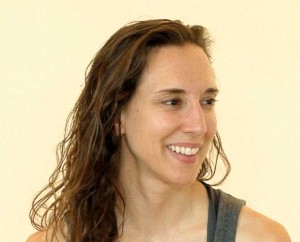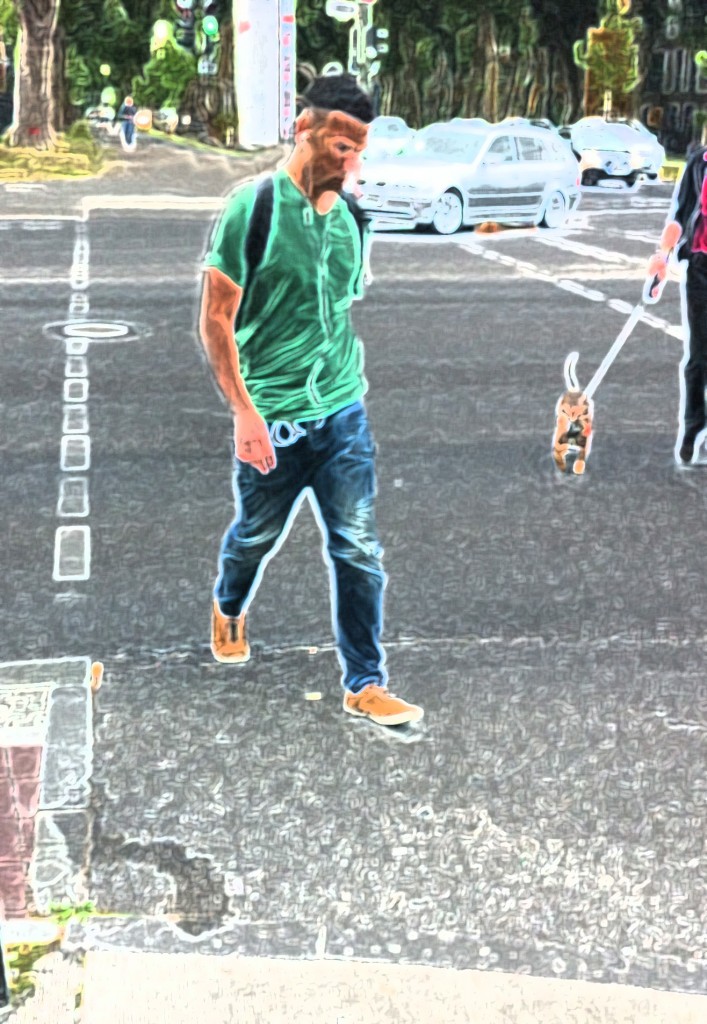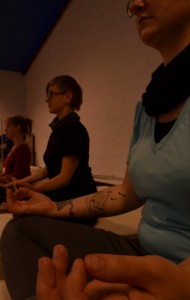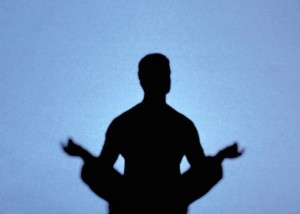
Personal Yoga Practice
For many people “doing yoga” means visiting a yoga studio and allowing themselves to be guided through some sequences and routines, without having to think too closely about what’s going on. Maybe it has something to do with our therapeutic culture, accustomed to experiencing well-being as something provided by a knowledgeable professional; or with our old tendency to transfer responsibility – to the doctor, to the legislator, to the child psychologist, to the yoga teacher… But given the popularity of yoga today, it is remarkable how few yogis practice yoga in daily life, on their own, in the quiet of their room.
That’s not too bad for us yoga teachers. After all, if everybody was doing yoga at home then we would struggle to make a living even more than we already do. But somehow, many of us are not comfortable with what we perceive as an unnecessary dependency. We certainly don’t what to stand between you and something as precious and important as your personal practice. Besides, we believe that if you had a regular home practice, you would get a lot more from your weekly studio visits, and make the yoga classes a little more challenging to us teachers.
In this blog we address some of the common questions we hear from people who are trying to establish and develop their home practice. There are no hard and fast answers when it comes to yoga, so please take the following lines as mere suggestions. This is why we include more than one answer to some of the queries. Be experimental – only you can find out what works for you.
Q. When is the best time to practice yoga?
A1. When you have time, naturally. It makes no sense to rearrange your life to fit your yoga practice; it’s better to arrange your yoga practice to fit your life. So the first consideration when trying to decide a time for yoga is: When is it convenient? Ideally you would do it always at the same time, so that it more easily becomes a routine; but if your day’s schedule varies a lot (i.e. people with rotating working hours) then your yoga schedule must necessarily reflect that. One helpful way to deal with an uncertain weekly schedule is to set your yoga practice in relationship to a regular activity (e.g. after getting home from work, before going to bed, etc). In that way, you ensure that yoga fits in regardless of the actual times at which things happen.
A2. When your stomach is empty. Having an empty stomach is one of the few rules of yoga practice. So it’s important to keep in mind your eating habits when deciding on a good time for doing yoga asanas. Schedule it before dinner, before lunch, or before breakfast. You can use your meals as a trigger for doing yoga, getting into the habit of hitting the mat before you hit the table.
A3. When there are fewer distractions. It seems obvious, but it’s worth mentioning. Schedule your practice around your friends’ visiting hours, or after the children go to school, or before your noisy flatmate returns from work. Let your yoga time follow the patterns of your environment and get on the mat when things are more calm and quiet. But beware of waiting for the perfect conditions! A good yoga session doesn’t depend on having a silent environment or on being left alone; it depends more on accepting the conditions as they are and experiencing your reactions without identifying with them. Meditation can happen anywhere.
A4. Anytime you need it. Remember, yoga is not just bending and stretching on a mat, doing what we think of as yoga poses. You can, in fact, do your yoga in many situations throughout your day: just before an important meeting (coming earlier to the conference room and practicing a bit of pranayama or breath awareness to ground yourself); on the way home from work (sitting with eyes closed and listening to the sounds while riding the bus); during a little break from typing that long school report (doing the shoulder rotation or other upper-back loosening exercises while sitting at your desk)… yoga benefits are as varied as yoga practice, and the possibilities are only limited by your imagination. Use your yoga as a tool to cope with the challenges of daily life. Make it gentle yoga or stronger stuff, and do it whenever you need it.
A5. Rather earlier than later. If you want to establish a regular yoga routine, it might be best to schedule your practice earlier in the day. This way if some unforeseen event gets on the way of your practice, you may still find an opportunity to do some yoga before the day is over.
Q. How Long and How Frequently Should One Practice?
A. Whatever doesn’t feel too ambitious. Any discerning yoga teacher will tell you that it’s best to do a little often, than a lot seldom. One of the biggest obstacles to beginners who want to develop a regular practice is to be overambitious. We want to do two hours daily and reach enlightenment before next year’s high-school reunion. Well, it doesn’t quite work like that. Sure, you may have an iron will and plenty of time to dedicate to yoga, but for most of us, mere mortals, it’s more realistic to start with 15 to 20 minutes, twice or thrice a week. Remember, nobody is making any demands on you; just do enough so that it doesn’t become a burden. Listen to yourself: How much can you manage? How much do you want? This is something you do because you want to – not to uphold some ideal or become your own role-model. And, most importantly: don’t be swayed by a bad conscience or yoga guilt if you have taken a long break from yoga. Just get back to the practice whenever you feel like it.
Q. Where is a Good Place to Practice?
A1. Anywhere. Just like you can practice yoga anytime (see the fourth answer to the first question), you can also do it anywhere. Lying in bed, just before going to sleep, you can do some rounds of the yogic breath. Sitting in a classroom, waiting for the next teacher to arrive, you can do the neck exercises. Hatha yoga poses are extremely flexible (ha, ha): standing by the kitchenette in a transatlantic flight is one of my favorite places to do the Stretching Palm, and you can do a great Eagle Arms sitting on the train.
A2. When at home, it’s good to have a dedicated space for doing yoga. It doesn’t have to be a fancy place (I’ve been using the walk-in closet in our flat for some advanced do-in-the-dark meditations), nor does it have to be a zen hall (I often have to push my son’s toys to one side of the play room to do my asana practice). Any space will do, regardless of size and condition – of course, if you plan to do Savasana, it’s probably good that there’s enough room to lie down; if you plan to do the Hello Sun, the ceiling should be high enough to raise your arms; and if you want to practice a more dynamic form, like vinyasa yoga, it would probably be helpful to have a bit of space around you. But you can almost certainly find a space that is good enough, right in your home–just use your creativity.
A3. If you’re lucky enough to have your pick of room for yoga, choose a well-ventilated, non-cluttered space; somewhere relatively calm where people are not constantly walking by. The ability to lower the light or draw a curtain over the windows would enhance the more meditative/healing practices, such as Yoga Nidra or restorative yoga.
A4 Yoga outdoors is not often feasible in northern latitudes, but it’s also a possibility during the warm season. However, you may find that some breathing exercises and advanced meditations are more conveniently done indoors. Make your own experiences!
Q. What Should I Do?
A1. Do what you feel like doing, do what you like. Your yoga session is no bitter medicine, it’s something you do to feel good, to enjoy yourself. Make it enjoyable and make it yours!
A2. Do two thirds of things that you like and one-third of things that you resist. The things that you like will make you feel good and want to do it again soon; they things that you resist are probably what you most need.
A3. Do asana (physical poses), pranayama (breathing exercises) and meditation or relaxation. In that order. Limiting your practice to just yoga asanas is like eating from only one food group – would you confine your diet to just carbohydrates?
A4. There are many resources you can tap for inspiration: YouTube, books, DVDs, etc. I would personally recommend my teacher’s book, one of the most concise and complete yoga manuals that exist today: Yoga Tantra and Meditation in Daily Life.
There are still many common questions, which we will try to answer in further posts. If you would like personal advice, or if you’re unsure how this all applies to you, contact us for more guidance.
English Yoga Berlin is a collective of teachers offering yoga in English from our yoga Berlin Kreuzberg studio. We offer hatha yoga, vinyasa yoga, restorative yoga, classical yoga and yoga nidra. We specialize in community yoga and offer yoga for beginners through advanced. We look forward to practicing with you!




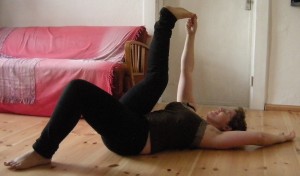
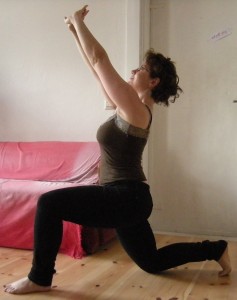 Aaaah, tight hip flexors. A sure sign of time spent sitting—in a chair, or on your bike. Every time you pull your foot up and over the pedal, you’re using your hip flexor. If they get too tight, especially in combination with tight hamstrings and weak abdominals, they’ll contribute to lower back pain. But never fear! You just gotta lunge.
Aaaah, tight hip flexors. A sure sign of time spent sitting—in a chair, or on your bike. Every time you pull your foot up and over the pedal, you’re using your hip flexor. If they get too tight, especially in combination with tight hamstrings and weak abdominals, they’ll contribute to lower back pain. But never fear! You just gotta lunge.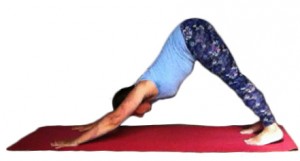 Whether you’re sitting up or bending forward on your bike, you’re going to need to have a strong back. That means strong shoulders (this also helps protect you in case of accidents: if they’re not strong, the shoulders dislocate more easily when you brace yourself during a fall or impact), strong paraspinals and—very importantly—strong abdominals. Downward Dog, when practiced correctly and regularly, will help you strengthen your whole spine and make it easier to ride without pain.
Whether you’re sitting up or bending forward on your bike, you’re going to need to have a strong back. That means strong shoulders (this also helps protect you in case of accidents: if they’re not strong, the shoulders dislocate more easily when you brace yourself during a fall or impact), strong paraspinals and—very importantly—strong abdominals. Downward Dog, when practiced correctly and regularly, will help you strengthen your whole spine and make it easier to ride without pain.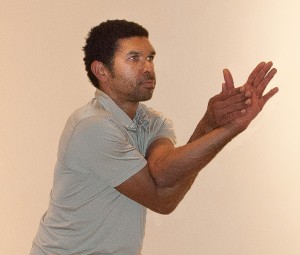 Holding onto your handlebars takes a lot of work in the arms and shoulders, especially if you’re cycling into the wind or uphill. Over time, cycling will help you to develop a stronger upper body. You can minimize pain and discomfort by taking the time to
Holding onto your handlebars takes a lot of work in the arms and shoulders, especially if you’re cycling into the wind or uphill. Over time, cycling will help you to develop a stronger upper body. You can minimize pain and discomfort by taking the time to 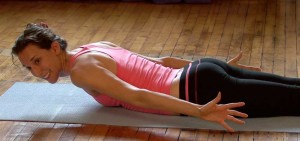 We’re excited to announce that, on August 22nd, our last community yoga class before the summer break will be taught by visiting functional anatomy specialist and yoga teacher Sara Hauber!
We’re excited to announce that, on August 22nd, our last community yoga class before the summer break will be taught by visiting functional anatomy specialist and yoga teacher Sara Hauber!